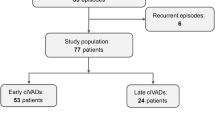Abstract
Background
In this study, we identify factors associated with ketamine success in the treatment of refractory status epilepticus (SE). We also evaluate for adverse events including systemic and cerebral hemodynamic stability and fluid volume overload.
Methods
In this retrospective, large, single-center, observational study over a 10-year period, 879 consecutive patients receiving intravenous (IV) ketamine were reviewed, and 81 patients were identified as receiving IV ketamine for the treatment of SE. Descriptive analysis was done to determine treatment response and adverse events in patients receiving IV ketamine for SE. Multivariable logistic regression analyses were fitted to determine prediction models for seizure cessation.
Results
Permanent cessation of SE was achieved in 49 of 81 (60.5%) of patients for whom ketamine was part of the treatment plan. Of those, 36 (44.4%) were attributed to ketamine as the last drug used (ketamine-associated cessation [AC]). Prior history of epilepsy had an odds ratio of 3.19 (confidence interval 0.83–12.67, p = 0.09) associated with efficacious medication response. Increased latency to ketamine was associated with cessation of SE specifically in patients in the AC group (p = 0.077). Longer SE duration (p = 0.04), administration of ketamine loading dose (bolus; p = 0.03), and anoxia (p = 0.007) were negatively associated with AC. Administration of ketamine loading dose (p = 0.02) and anoxia (p = 0.009) were negatively associated with overall SE cessation. There was no significant impact of ketamine on cerebral hemodynamics, but evidence of fluid volume overload was seen (28.4% of patients).
Conclusions
Our cohort is a large observational study showing a high success rate of permanent cessation of SE after the addition of ketamine. Using multivariable analysis, we demonstrate a significant association with seizure cessation in patients with prior history of epilepsy and those with prolonged latency to ketamine initiation. Furthermore, we describe the impact of fluid volume overload as an anticipated complication with ketamine use.
Similar content being viewed by others
References
Rosati A, L’Erario M, Ilvento L, et al. Efficacy and safety of ketamine in refractory status epilepticus in children. Neurology. 2012;79:2355–8.
Synowiec AS, Singh DS, Yenugadhati V, Valeriano JP, Schramke CJ, Kelly KM. Ketamine use in the treatment of refractory status epilepticus. Epilepsy Res. 2013;105:183–8.
Basha MM, Alqallaf A, Shah AK. Drug-induced EEG pattern predicts effectiveness of ketamine in treating refractory status epilepticus. Epilepsia. 2015;56:e44–8.
Gaspard N, Foreman B, Judd LM, et al. Intravenous ketamine for the treatment of refractory status epilepticus: a retrospective multicenter study. Epilepsia. 2013;54:1498–503.
Alkhachroum A, Der-Nigoghossian CA, Mathews E, et al. Ketamine to treat super-refractory status epilepticus. Neurology. 2020;95:e2286–94.
Trinka E, Cock H, Hesdorffer D, et al. A definition and classification of status epilepticus–report of the ILAE task force on classification of status epilepticus. Epilepsia. 2015;56:1515–23.
Claassen J, Hirsch LJ, Emerson RG, Mayer SA. Treatment of refractory status epilepticus with pentobarbital, propofol, or midazolam: a systematic review. Epilepsia. 2002;43:146–53.
Shorvon S, Ferlisi M. The treatment of super-refractory status epilepticus: a critical review of available therapies and a clinical treatment protocol. Brain. 2011;134:2802–18.
Borris DJ, Bertram EH, Kapur J. Ketamine controls prolonged status epilepticus. Epilepsy Res. 2000;42:117–22.
Savage DD, Werling LL, Nadler JV, McNamara JO. Selective increase in L-[3H]glutamate binding to a quisqualate-sensitive site on hippocampal synaptic membranes after angular bundle kindling. Eur J Pharmacol. 1982;85:255–6.
Yeh GC, Bonhaus DW, Nadler JV, McNamara JO. N-methyl-D-aspartate receptor plasticity in kindling: quantitative and qualitative alterations in the N-methyl-D-aspartate receptor-channel complex. Proc Natl Acad Sci U S A. 1989;86:8157–60.
Franck JE, Pokorny J, Kunkel DD, Schwartzkroin PA. Physiologic and morphologic characteristics of granule cell circuitry in human epileptic hippocampus. Epilepsia. 1995;36:543–58.
Louvel J, Pumain R, Avoli M, Kurcewicz I, Devaux B, Chodkiewicz JP. GABAA inhibition controls the calcium flows during NMDA-dependent epileptiform activity in human epileptogenic neocortex. Epilepsy Res Suppl. 1996;12:293–300.
Huberfeld G, Menendez de la Prida L, Pallud J, et al. Glutamatergic pre-ictal discharges emerge at the transition to seizure in human epilepsy. Nat Neurosci. 2011;14:627–34.
McGinnity CJ, Koepp MJ, Hammers A, et al. NMDA receptor binding in focal epilepsies. J Neurol Neurosurg Psychiatry. 2015;86:1150–7.
Goodkin HP, Kapur J. The impact of diazepam’s discovery on the treatment and understanding of status epilepticus. Epilepsia. 2009;50:2011–8.
Rossetti AO, Logroscino G, Liaudet L, et al. Status epilepticus: an independent outcome predictor after cerebral anoxia. Neurology. 2007;69:255–60.
Lybeck A, Friberg H, Nielsen N, et al. Postanoxic electrographic status epilepticus and serum biomarkers of brain injury. Resuscitation. 2021;158:253–7.
Funding
This work received no funding.
Author information
Authors and Affiliations
Contributions
MS: data collection, formatting, literature review, article writing. DP: expert pharmacological opinion, literature review, article editing. SM: interpretation of data and statistical analysis, article editing. RM: literature review, article editing. DZ: literature review, article editing. MMB: conceptualization of idea, data collection and review, literature review, article writing. The authors have read and approved the final manuscript.
Corresponding author
Ethics declarations
Conflicts of interest
None of the authors have any conflicts of interests to disclose.
Ethical Approval/Informed Consent
On behalf of all the authors, I confirm that the manuscript complies with all the instructions to authors, authorship requirements have been met and the final manuscript was approved by all authors. The manuscript has not been published in part of full elsewhere and is not under consideration by another journal. The authors have adhered to ethical guidelines and sought IRB approval prior to the initiation of study.
Additional information
Publisher's Note
Springer Nature remains neutral with regard to jurisdictional claims in published maps and institutional affiliations.
Rights and permissions
Springer Nature or its licensor holds exclusive rights to this article under a publishing agreement with the author(s) or other rightsholder(s); author self-archiving of the accepted manuscript version of this article is solely governed by the terms of such publishing agreement and applicable law.
About this article
Cite this article
Srinivas, M., Parker, D., Millis, S. et al. Factors Associated with Refractory Status Epilepticus Termination Following Ketamine Initiation: A Multivariable Analysis Model. Neurocrit Care 38, 235–241 (2023). https://doi.org/10.1007/s12028-022-01578-0
Received:
Accepted:
Published:
Issue Date:
DOI: https://doi.org/10.1007/s12028-022-01578-0




